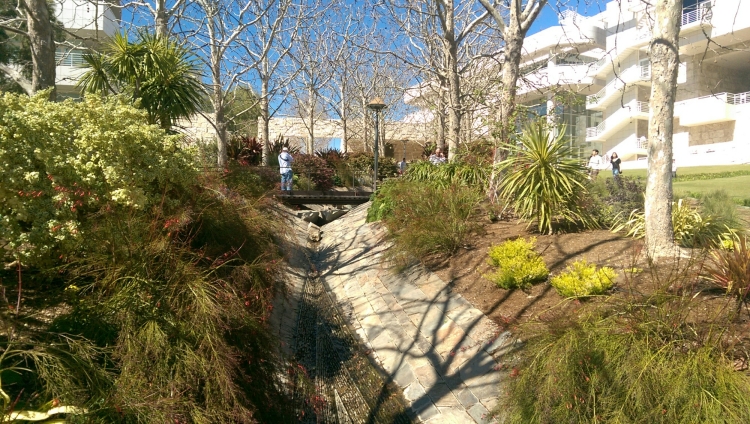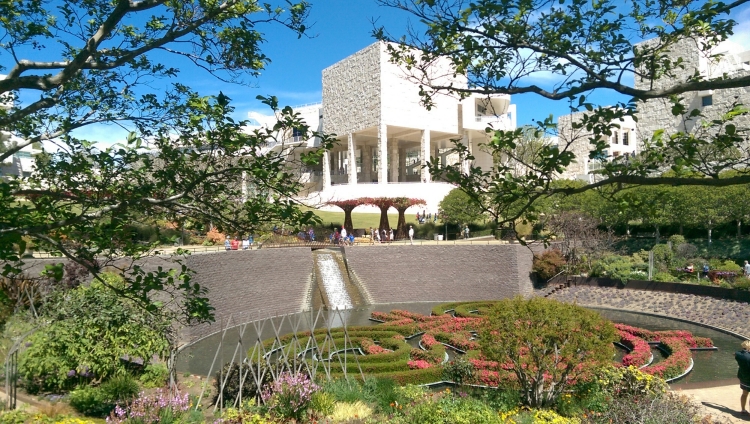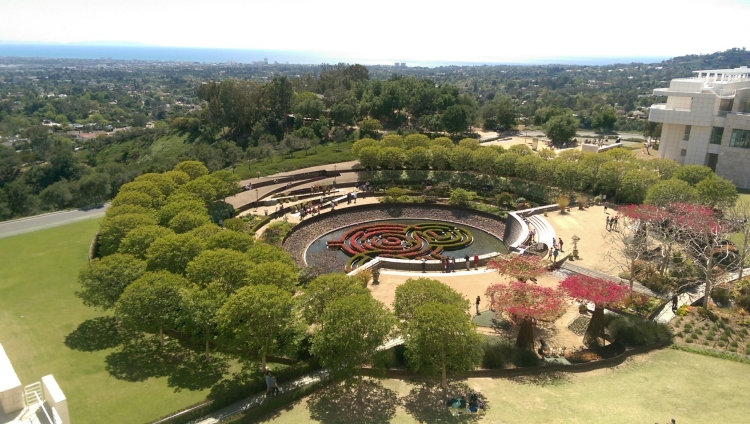It has taken me five years finally to return to the Getty Museum to visit Robert Irwin’s garden. In 2011 I visited the Getty Museum high above LA, but missed the garden altogether, too overwhelmed by the arrival, the buildings and the collection to realise that an even more extraordinary experience was waiting for me a few steps away. I made an attempt to see it with my family in 2013, but jetlag got the better of us.
In 2011, I had arrived at the Getty having just seen Irwin speak at the LA County Museum of Art. Reading the book of his interviews “Seeing is Forgetting the Name of the Thing One Sees” inspired me subsequently to enrol in Contemporary Art History and research Irwin and his art in some depth.
So to say there was some build up to this present visit is an understatement.
Robert Irwin began his artistic practice in the 1950s with abstract expressionist works characteristic of the times. Not satisfied – he calls them “brown scratchings” now – he began a remarkable career of continuous innovation, along the way cofounding the Light and Space Movement in the 70s, and then branching out into installation art – first with ephemeral interventions within the art museum context, and subsequently with major external public commissions.
With the Getty garden, Irwin’s journey seems to have come full circle – he started with a strong desire for his art to leave the confines of the two dimensional frame, then for his art to leave the wall and influence the viewers’ perceptual experience of the art space, then leave the confines of the gallery altogether, only now to return to provide a fundamental framing experience for a whole museum. This is an astounding achievement.
As I sit to write this in the Getty garden, at last, on a bench in the dappled shade of a crepe myrtle, the smell of garlic reminds me of my Nanna’s garden, and memories come to me of that wonderland – gone now, like the Hanging Garden – the myth still growing with each remembered scent.
Through a series of steel and herbaceous brush strokes, Irwin’s criss-crossing pathways promote the release of external pressures and provide sensory milestones that encourage me to feel like I am walking through a giant artwork. But nothing prepared me for the emotional impact of the central azalea water maze. The last place I felt this strongly about a man made landscape was the Taj Mahal.
Given there was some controversy surrounding Irwin’s selection for the Getty Garden commission over Richard Meier, the architect of the Getty Museum itself, it would not have been unexpected to feel a sense of competition, or at least an assertion of conflicting ideologies, between built form and landscape, straight lines and organic sweeps. But Irwin is evidently a generous man, as the garden more than respects its neoclassical surrounds – the central water feature finds its source in an amphora shaped cavern, certain vistas align with buildings, and certain plant choices relate to choices of building material (such as the bark of the plane trees and the patina of the travertine blocks).
As artists for centuries have striven to understand and interact with the multiple perspectives of the viewer, it is interesting to contemplate how the garden provides a possible resolution. No two viewing experiences are the same, and one returns each time to a different garden, through seasonal changes, time of day, weather, and inevitable death and decay (of plant and person). The gift of the gardener is to curate a platform for an infinite variety of individual experiences.
But in the face of this plurality, in the end Irwin guides us to the “power spot”, a place more awe inspiring than the buildings’ formal symmetry could have achieved alone. At this single point, looking back, the entire site is in perspective – a special case within a much broader experience.
Irwin’s achievement is stunning, demonstrating once again his ability to innovate across multiple decades and different media. The only puzzle to me is why this artist is not better known. Perhaps his shape shifting has worked against his fame, but I sense that means not a lot to Irwin, who is more than prepared to let his work speak for itself.



Makes me want to visit Paul. Beautifully observed. K
LikeLike